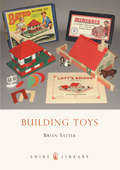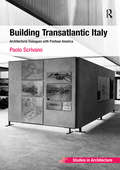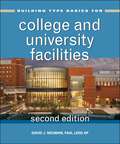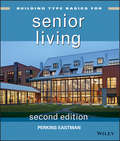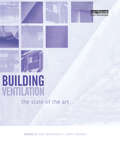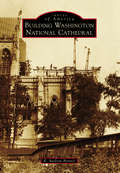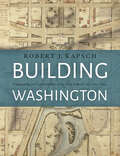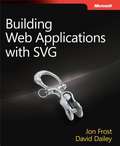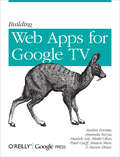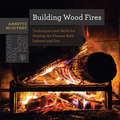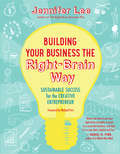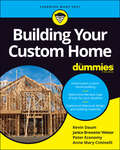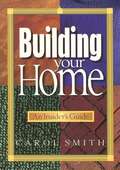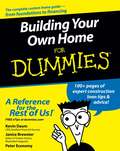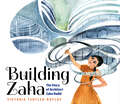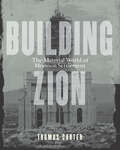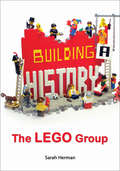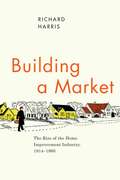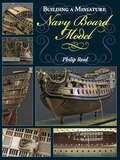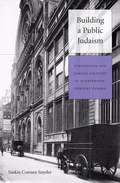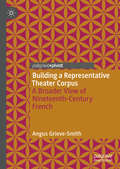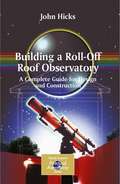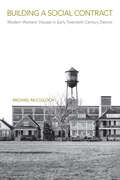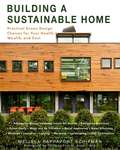- Table View
- List View
Building Tough Towers (Fun STEM Challenges)
by Marne VenturaWhat does it take to make a tough tower? Gather some supplies and try it out for yourself! Discover tips and ideas on how to build the best tower around!
Building Toys
by Brian SalterBuilding blocks have been a familiar presence in children's toy collections for generations, but in the twentieth century new production techniques allowed the building brick to evolve into a multiplicity of systems that could make any child his or her own architect and skilled builder, capable of constructing realistic and sturdy miniature buildings. This highly illustrated book is devoted to British building toys with all the major brands and some of the minor ones represented. Photographs of sets, completed buildings and the box art and advertising material that were used to sell these toys make this book a feast of nostalgia for anyone who grew up in the middle years of the last century, and an invaluable source of information for any collectors who keep the memory of these toys alive today.From the Trade Paperback edition.
Building Transatlantic Italy: Architectural Dialogues with Postwar America (Ashgate Studies in Architecture)
by Paolo ScrivanoAt the end of the Second World War, America’s newly acquired status of hegemonic power- together with the launch of ambitious international programs such as the Marshall Plan- significantly altered existing transatlantic relations. In this context, Italian and American architectural cultures developed a fragile dialogue characterized by successful exchanges and forms of collaboration but also by reciprocal wariness. The dissemination of models and ideas concerning architecture generated complex effects and frequently led to surprising misinterpretations, obstinate forms of resistance and long negotiations between the involved parties. Issues of continuity and discontinuity dominated Italian culture and society at the time since at stake was the possible balance between allegedly long-established traditions and the prospect of a radical rupture with recent history. Architectural culture often contributed to reach a compromise between very diverging attitudes. Situated in the larger realm of studies on Americanization, this book questions current interpretations of transatlantic relations in architecture. By reconsidering the means and effects of the dialogue that unfolded between the two sides of the Atlantic during the postwar years, the volume analyzes how cultural and formal models were developed in one context and then modified when transferred to a new one as well as the fortune of this cultural exchange in terms of circulation, amplification, and simplification.
Building Type Basics for College and University Facilities
by David J. NeumanEssential information for the design of college and university facilities Building Type Basics for College and University Facilities, Second Edition is your one-stop reference for the essential information you need to confidently begin the planning process and successfully complete the design of college and university buildings, large or small, on time and within budget. Award-winning architect and planner David J. Neuman and a roster of industry-leading contributors share their firsthand knowledge to guide you through all aspects of planning higher education facilities, including learning centers, academic buildings and professional schools, scientific research facilities, housing, athletics and recreation facilities, social and support facilities, and cultural centers. The book combines up-to-date coverage of essential issues related to campus planning, programming, and building design guidelines with detailed project examples. This new edition offers: Numerous photographs, diagrams, plans, and sections Updated project examples, including several buildings completed in the last decade Up-to-date coverage of sustainability and technology issues A new chapter on historic preservation, rehabilitation, and adaptive use of existing buildings New material on the influence of interdepartmental collaboration and renewed communication on the built environment for campuses This conveniently organized quick reference is an invaluable guide for busy, dedicated professionals who want to get educated quickly as they embark on a new project. Like every Building Type Basics book, it provides authoritative, up-to-date information instantly and saves professionals countless hours of research.
Building Type Basics for Senior Living
by Perkins EastmanEssential information for the design of senior living facilities Building Type Basics for Senior Living, Second Edition is your one-stop reference for essential information you need to plan and successfully complete the design of residential care environments for seniors on time and within budget. Primary authors Bradford Perkins and J. David Hoglund and their Perkins Eastman colleagues-all experts in senior living design-share firsthand knowledge to guide you through all aspects of the design of senior living communities, including independent living and assisted living apartments, and skilled nursing facilities. This edition features new examples of completed projects and is up to date with the latest developments in senior living design, including coverage of sustainable design, renovation and reinvention, international opportunities, operations, and project financing. This new edition offers: Numerous photographs, diagrams, and plans A new chapter on issues, trends, and challenges for the senior living industry in the next decade A new chapter devoted to sustainability strategies and considerations Up-to-date coverage of new technologies being implemented in senior living facilities New space programming standards and sample programs Like every Building Type Basics book, this conveniently organized quick reference provides authoritative, up-to-date information instantly and saves professionals countless hours of research.
Building Ventilation: The State of the Art
by Mat Santamouris Peter WoutersEnsuring optimum ventilation performance is a vital part of building design. Prepared by recognized experts from Europe and the US, and published in association with the International Energy Agency's Air Infiltration and Ventilation Centre (AIVC), this authoritative work provides organized, classified and evaluated information on advances in the key areas of building ventilation, relevant to all building types. Complexities in airflow behaviour, climatic influences, occupancy patterns and pollutant emission characteristics make selecting the most appropriate ventilation strategy especially difficult. Recognizing such complexities, the editors bring together expertise on each key issue. From components to computer tools, this book offers detailed coverage on design, analysis and performance, and is an important and comprehensive publication in this field. Building Ventilation will be an invaluable reference for professionals in the building services industry, architects, researchers (including postgraduate students) studying building service engineering and HVAC, and anyone with a role in energy-efficient building design.
Building Washington National Cathedral (Images of America)
by R. Andrew BittnerWashington National Cathedral is a Gothic great church built between 1907 and 1990. Despite being built entirely during the 20th century, the techniques used were the same as those used on the centuries-old Gothic churches in Europe. What powered the larger tools and cranes was different, but otherwise, the processes, ordering, and artistic finishing were almost entirely medieval. The last time a building of this magnitude was built using these techniques, cameras did not exist. Images of America: Building Washington National Cathedral divides the 20th century into decades to detail what must be the first published beginning-to-completion photographic record of the construction of a Gothic cathedral.
Building Washington: Engineering and Construction of the New Federal City, 1790−1840
by Robert J. KapschA richly illustrated behind-the-scenes tour of how the nation’s capital was built.In 1790, George Washington and Thomas Jefferson set out to build a new capital for the United States of America in just ten years. The area they selected on the banks of the Potomac River, a spot halfway between the northern and southern states, had few resources or inhabitants. Almost everything needed to build the federal city would have to be brought in, including materials, skilled workers, architects, and engineers. It was a daunting task, and these American Founding Fathers intended to do it without congressional appropriation.Robert J. Kapsch’s beautifully illustrated book chronicles the early planning and construction of our nation’s capital. It shows how Washington, DC, was meant to be not only a government center but a great commercial hub for the receipt and transshipment of goods arriving through the Potomac Canal, then under construction. Picturesque plans would not be enough; the endeavor would require extensive engineering and the work of skilled builders. By studying an extensive library of original documents—from cost estimates to worker time logs to layout plans—Kapsch has assembled a detailed account of the hurdles that complicated this massive project. While there have been many books on the architecture and planning of this iconic city, Building Washington explains the engineering and construction behind it.
Building Web Applications with SVG
by David Dailey Jon Frost Domenico StrazzulloCreate rich interactivity with Scalable Vector Graphics (SVG) Dive into SVG--and build striking, interactive visuals for your web applications. Led by three SVG experts, you'll learn step-by-step how to use SVG techniques for animation, overlays, and dynamic charts and graphs. Then you'll put it all together by building two graphic-rich applications. Get started creating dynamic visual content using web technologies you're familiar with--such as JavaScript, CSS, DOM, and AJAX. Discover how to: Build client-side graphics with little impact on your web server Create simple user interfaces for mobile and desktop web browsers Work with complex shapes and design reusable patterns Position, scale, and rotate text elements using SVG transforms Create animations using the Synchronized Multimedia Integration Language (SMIL) Build more powerful animations by manipulating SVG with JavaScript Apply filters to sharpen, blur, warp, reconfigure colors, and more Make use of programming libraries such as Pergola, D3, and Polymaps
Building Web Apps for Google TV
by Andres Ferrate Maile Ohye Amanda Surya Daniels Lee Shawn Shen Steven Hines Paul CarffBy integrating the Web with traditional TV, Google TV offers developers an important new channel for content. But creating apps for Google TV requires learning some new skills—in fact, what you may already know about mobile or desktop web apps isn't entirely applicable. Building Web Apps for Google TV will help you make the transition to Google TV as you learn the tools and techniques necessary to build sophisticated web apps for this platform.This book shows you how Google TV works, how it fits into the web ecosystem, and what the opportunities are for delivering rich content to millions of households.Discover the elements of a compelling TV web app, and what comprises TV-friendly navigationLearn the fundamentals for designing the 10-foot user experienceWork with the Google Chrome browser on a TV display, and migrate an existing siteUse examples for developing a TV web app, including the UI, controls, and scrollingUnderstand how to optimize, deliver, and protect video content for Google TVHelp users discover your content by optimizing your site for Search—especially videos
Building Wood Fires: Techniques And Skills For Stoking The Flames Both Indoors And Out (Countryman Know How #0)
by Annette McGivneyLearn everything there is to know about building a wood fire. Fire has brought humans together for millennia. The cozy warmth of the hearth and the adventure of the campfire draw the same attention today as they did 100 years ago. Part how-to, part history of fire, Building Wood Fires is an essential guide for anyone with a fireplace, backyard fire pit, or love of camping. Outdoor journalist and wilderness expert Annette McGivney shares years of expertise, providing tips from whereto build your fire pit to how to roast the perfect marshmallow and helpful diagrams to demonstrate essential techniques.
Building Your Business the Right-Brain Way
by Jennifer Lee Kate PrentissGrow a Profitable and Lasting Business on Your Terms If you've started a business, you know that the journey toward success can be both invigorating and confusing, so where can you find advice that is practical and focused but still as playful and passionate as you are? Look no further than this book, which combines solid business expertise with a right-brain perspective that inspires creativity and innovation. Jennifer Lee's fresh, empowering approach emphasizes taking action and continually improving to achieve extraordinary long-term results. Building Your Business the Right-Brain Way offers real-world-tested techniques that can benefit all sorts of businesses, whether you're a sole proprietor running a coaching practice, a crafter looking to license products, a wellness professional with a team of employees, or any creative soul making a meaningful difference with your work. You'll discover how to: * assess your business's unique "ecosystem" * build your brand and attract, engage, and keep ideal customers * develop new income streams that better leverage your time and resources * promote your products and services with authenticity and ease * grow your team (virtual and in-person) and manage staff and vendors * establish infrastructure and procedures to keep operations running smoothly * carve out vital white space to pause, reflect, and celebrate Includes play sheets and color illustrations to inspire action and propel your success
Building Your Custom Home For Dummies
by Peter Economy Kevin Daum Janice Brewster Anne Mary CiminelliBuild a place you’ll love to come home to Why settle for a house that looks like every other one in the neighborhood? With Building Your Custom Home For Dummies on your desk (right alongside those inspiring architecture magazines), you can design and build the home of your dreams. From brainstorming must-have features to hanging a wreath on the front door, this book walks you through what you need to know from start to finish. Get savvy on purchasing property, securing financing, and raising the walls that will become the setting for life’s next chapter. If you can imagine it, you can build it! Inside… Locate your ideal building site Hire an architecture and contracting team you can trust Finance smoothly and manage your construction budget Discover new green building techniques Oversee construction from A to Z Furnish, landscape, and maintain your property
Building Your Home: An Insider's Guide
by Carol SmithIn the second edition of Building Your Home: An Insider's Guide, customer service expert Carol Smith shows you how to work with your builder to create the home of your dreams. This guide is a must-have for anyone planning to build a high-quality home. With this comprehensive, step-by-step book, you can avoid common mistakes in the home building process and choose a qualified builder, establish your budget and secure financing, select the location, benefits, and features of your new home, participate effectively in the design and building process, prepare for home owner orientation, closing, and moving in, create a home maintenance plan, communicate with your builder on warranty service.
Building Your Own Home For Dummies
by Peter Economy Kevin Daum Janice BrewsterKeep construction on track with helpful checklists Turn your dream of a custom home into reality! Thinking about building your own home? This easy-to-follow guide shows you how to plan and build a beautiful home on any budget. From acquiring land to finding the best architect to overseeing the construction, you get lots of savvy tips on managing your new investment wisely -- and staying sane during the process! Discover how to: * Find the best homesite * Navigate the plan approval process * Obtain financing * Hire the right contractor * Cut design and construction costs * Avoid common mistakes
Building Zaha: The Story of Architect Zaha Hadid
by Victoria Tentler-KrylovAn inspiring picture book biography about British Iraqi architect Zaha Hadid, who was a pioneer in her field against all odds, told by debut author-illustrator Victoria Tentler-Krylov.The city of Baghdad was full of thinkers, artists, and scientists, the littlest among them Zaha Hadid. Zaha knew from a young age that she wanted to be an architect. She set goals for herself and followed them against all odds. A woman in a man's world, and a person of color in a white field, Zaha was met with resistance at every turn. When critics called her a diva and claimed her ideas were unbuildable, she didn't let their judgments stop her from setting goals and achieving them one by one, finding innovative ways to build projects that became famous the world over. She persisted, she followed her dreams, and she succeeded.
Building Zion: The Material World of Mormon Settlement (Architecture, Landscape and Amer Culture)
by Thomas CarterFor Mormons, the second coming of Christ and the subsequent millennium will arrive only when the earth has been perfected through the building of a model world called Zion. Throughout the nineteenth century the Latter-day Saints followed this vision, creating a material world—first in Missouri and Illinois but most importantly and permanently in Utah and surrounding western states—that serves as a foundation for understanding their concept of an ideal universe.Building Zion is, in essence, the biography of the cultural landscape of western LDS settlements. Through the physical forms Zion assumed, it tells the life story of a set of Mormon communities—how they were conceived and constructed and inhabited—and what this material manifestation of Zion reveals about what it meant to be a Mormon in the nineteenth century. Focusing on a network of small towns in Utah, Thomas Carter explores the key elements of the Mormon cultural landscape: town planning, residences (including polygamous houses), stores and other nonreligious buildings, meetinghouses, and temples. Zion, we see, is an evolving entity, reflecting the church&’s shift from group-oriented millenarian goals to more individualized endeavors centered on personal salvation and exaltation. Building Zion demonstrates how this cultural landscape draws its singularity from a unique blending of sacred and secular spaces, a division that characterized the Mormon material world in the late nineteenth century and continues to do so today.
Building a History: The Lego Group
by Sarah HermanThe story of these beloved bricks and the people who built an empire with them. From its inception in the early 1930s right up until today, the LEGO Group&’s history is as colorful as the toys it makes. Few other playthings share the LEGO brand&’s creative spirit, educational benefits, resilience, quality, and universal appeal. This history charts the birth of the LEGO Group from the workshop of a Danish carpenter and its steady growth as a small, family-run toy manufacturer to its current position as a market-leading, award-winning brand. The company&’s growing catalogue of products—including the earliest wooden toys, plastic bricks, play themes and other building systems such as DUPLO, Technic, and MINDSTORMS—are chronicled in detail, alongside the manufacturing process, LEGOLAND parks, licensed toys, and computer games. Learn all about how LEGO pulled itself out of an economic crisis and embraced technology to make building blocks relevant to twenty-first century children, and discover the vibrant fan community of kids and adults whose conventions, websites, and artwork keep the LEGO spirit alive. Building a History will have you reminiscing about old Classic Space sets, rummaging through the attic for forgotten minifigure friends, and playing with whatever LEGO bricks you can get your hands on (even if it means sharing with your kids).
Building a Market: The Rise of the Home Improvement Industry, 1914-1960
by Richard HarrisEach year, North Americans spend as much money fixing up their homes as they do buying new ones. This obsession with improving our dwellings has given rise to a multibillion-dollar industry that includes countless books, consumer magazines, a cable television network, and thousands of home improvement stores. Building a Market charts the rise of the home improvement industry in the United States and Canada from the end of World War I into the late 1950s. Drawing on the insights of business, social, and urban historians, and making use of a wide range of documentary sources, Richard Harris shows how the middle-class preference for home ownership first emerged in the 1920s--and how manufacturers, retailers, and the federal government combined to establish the massive home improvement market and a pervasive culture of Do-It-Yourself. Deeply insightful, Building a Market is the carefully crafted history of the emergence and evolution of a home improvement revolution that changed not just American culture but the American landscape as well.
Building a Miniature Navy Board Model
by Philip ReedThe expert model maker takes readers through every stage of building a miniature navy board model in this fully illustrated step-by-step guide. In this clear and detailed volume, Phil Reed tackles the ultimate expression of the ship model maker's art: The Navy Board model. These early eighteenth-century works of art are well represented in major maritime museums and private collections. Here, Reed takes on the construction of a miniature 1/192 scale model of the Royal George of 1715, covering all the conventions of Navy Board framing and planking. With nearly 400 photographs, each accompanied by explanatory text, Building a Miniature Navy Board Model takes readers through every step of the process. Methods of hull and deck framing, internal and external planking, and the construction of the complex stern are all covered. The rendering of the multitude of decorative carvings on the figurehead, stern and broadside is also demonstrated. At the end of the book there is a short section showing his model of The Syren, which demonstrates how the techniques used to frame Royal George could be adapted for ships of a later date, using single and double frames closer to full-size practice
Building a Public Judaism
by Saskia Coenen SnyderNineteenth-century Europe saw an unprecedented rise in the number of synagogues. Building a Public Judaism considers what their architecture and the circumstances surrounding their construction reveal about the social progress of modern European Jews. Looking at synagogues in four important centers of Jewish lifeâLondon, Amsterdam, Paris, and BerlinâSaskia Coenen Snyder argues that the process of claiming a Jewish space in European cities was a marker of acculturation but not of full acceptance. Whether modest or spectacular, these new edifices most often revealed the limits of European Jewish integration. Debates over building initiatives provide Coenen Snyder with a vehicle for gauging how Jews approached questions of self-representation in predominantly Christian societies and how public manifestations of their identity were received. Synagogues fused the fundamentals of religion with the prevailing cultural codes in particular locales and served as aesthetic barometers for European Jewryâs degree of modernization. Coenen Snyder finds that the dialogues surrounding synagogue construction varied significantly according to city. While the larger story is one of increasing self-agency in the public life of European Jews, it also highlights this agencyâs limitations, precisely in those places where Jews were thought to be most acculturated, namely in France and Germany. Building a Public Judaism grants the peculiarities of place greater authority than they have been given in shaping the European Jewish experience. At the same time, its place-specific description of tensions over religious tolerance continues to echo in debates about the public presence of religious minorities in contemporary Europe.
Building a Representative Theater Corpus: A Broader View of Nineteenth-Century French
by Angus Grieve-SmithThe Digital Parisian Stage Project aims to compile a corpus of plays that are representative of performances in the theaters of Paris through history. This book surveys existing corpora that cover the nineteenth century, lays out the issue of corpus representativeness in detail, and, using a random sample of plays from this period, presents two case studies of language in use in the Napoleonic era. It presents a compelling argument for the compilation and use of representative corpora in linguistic study, and will be of interest to those working in the fields of corpus linguistics, digital humanities, and history of the theater.
Building a Roll-Off Roof Observatory: A Complete Guide for Design and Construction (The Patrick Moore Practical Astronomy Series)
by John Stephen HicksAlmost every amateur astronomer who has taken the pursuit to its second level aspires to a fixed, permanent housing for his telescope, permitting its rapid and comfortable use avoiding hours of setting-up time for each observing session. A roll-off roof observatory is the simplest and by far the most popular observatory design for today's practical astronomers. Building a Roll-off Roof Observatory is unique, covering all aspects of designing a roll-off roof observatory: planning the site, viewing requirements, conforming to by-laws, and orientation of the structure. The chapters outline step-by-step construction of a typical building. The author, both an amateur astronomer and professional landscape architect, is uniquely qualified to write this fully-detailed book. A professionally designed roll-off observatory could cost as much as $3000 just for the plans - which are provided free with Building a Roll-off Roof Observatory.
Building a Social Contract: Modern Workers' Houses in Early-Twentieth Century Detroit (Urban Life, Landscape and Policy)
by Michael McCullochThe dream of the modern worker’s house emerged in early twentieth-century America as wage earners gained access to new, larger, and better-equipped dwellings. Building a Social Contract is a cogent history of the houses those workers dreamed of and labored for. Michael McCulloch chronicles the efforts of employers, government agencies, and the building industry who, along with workers themselves, produced an unprecedented boom in housing construction that peaked in the mid-1920s. Through oral histories, letters, photographs, and period fiction, McCulloch traces wage earners’ agency in negotiating a new implicit social contract, one that rewarded hard work with upward mobility in modern houses. This promise reflected workers’ increased bargaining power but, at the same time, left them increasingly vulnerable to layoffs. Building a Social Contract focuses on Detroit, the quintessential city of the era, where migrant workers came and were Americanized, and real estate agents and the speculative housebuilding industry thrived. The Motor City epitomized the struggle of Black workers in this period, who sought better lives through industrial labor but struggled to translate their wages into housing security amid racist segregation and violence. When Depression-era unemployment created an eviction crisis, the social contract unraveled, and workers rose up—at the polls and in the streets—to create a labor movement that reshaped American capitalism for decades. Today, the lessons McCulloch provides from early twentieth-century Detroit are a necessary reminder that wages are not enough, and only working-class political power can secure affordable housing.
Building a Sustainable Home: Practical Green Design Choices for Your Health, Wealth, and Soul
by Schifman MelissaThe green building movement has produced hundreds of “how-to” books and websites that are filled with tips about green building and what homeowners should do to go green. While helpful and informative, when it comes to making actual purchasing and installation decisions, these books do not make it any easier for a homeowner to prioritize against a budget. The Sustainable Home serves this need, as it is written by a sustainability advisor and financial advisor who has personally directed the building and LEED certification of her own home. Here, she shares her knowledge and experience for others to use in their journey toward a greener way of living. Whether the reader is building a new home or doing a minor remodel, a homeowner needs a framework by which to guide their decisions. These decisions are based on values, and the author posits that there are really only three reasons to go green: For Our Health: By building more sustainably, we reduce our exposure to harmful chemicals and toxins. For Our Wealth: By building a more durable home and being more efficient with resources like water and electricity, we reduce our monthly utility bills and ongoing maintenance expenses. For Our Soul: Collectively doing the right thing for our planet does make a difference—and that is soul-nourishing. Learn the logistics of choosing windows, insulation, appliances, and lighting. Find out about FSC certified wood and about using reclaimed materials. Here is everything you need to make your home sustainable.

